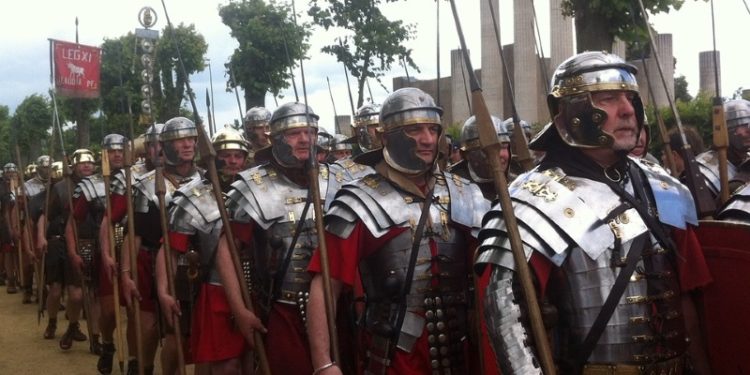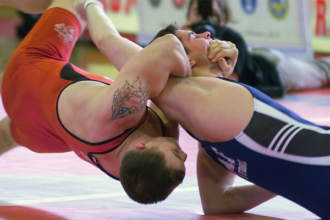The Fighter Class, Part Five

It hardly seems like it could have been a month since my last History of the Fighter article, but it was; ring out the bells for its return. I always wonder which edition the greatest number of people started on, and which holds the greatest space in their memory (possibly the same as the first they played, possibly not). I see polls that touch on this all the time, but only as they are in progress – never their results. Anyway, I got my start in 2e, and played it for more years than any other edition, but internally, that doesn’t slow me down from treating 3.x as a kind of baseline. So here we are in my “default” edition with the most default of all PC classes.
Part One | Part Two | Part Three | Part Four | Part Five
3.0
The flavor text for the 3.0 fighter covers the same ground as we’ve seen in other editions: “this class represents a huge variety of characters.” Basically, if you’re tough, use a weapon, and don’t use magic, this is the class for you! All of the other classes carving off narrower character-concept niches, kind of defined by how they aren’t fighters.
- d10 Hit Dice
- Proficiency in all armor and shields (because there’s no “exotic” armor you need to spend a feat slot to use… yet)
- Proficiency in simple and martial weapons. As you probably know, a bunch of weapons got cordoned off as Exotic Weapons, and thus require a feat to use.
- 2 + Int skill points per level, and a very short list of class skills: Climb, Craft, Handle Animal, Jump, Ride, Swim.
- The tiny number of skill points and short class skill list is probably my sharpest critique of not only the fighter class, but of 3.x’s whole approach to skills. It as much as declares that fighters must find all of their fun in combat, because their class features are trying to prevent them from engaging with the game outside of combat. There’s a total absence of support for fighter-as-leader, even though it’s well-nigh universal in fiction, and strongly represented in earlier editions through the whole system of followers.
- Fighters also don’t have access to Spot or Listen in-class, on top of not really being able to prioritize Wisdom. Guards who should be on the lookout for thieves or assassins… should not be fighters, no matter what the flavor text of the fighter class suggests! (This is one of the most unforgivable sins of the edition to me. I may have lost some perspective here.)
- +1/1 base attack bonus (BAB) progression, which is the fastest that the game includes.
- Because of how feat prerequisites work, gaining one point of BAB at 1st level makes a huge difference in potential starting builds. Keep in mind that everyone gets at least one feat at 1st level, while fighters gain another, and humans likewise. A lot of combat-related feats that initiate long feat chains require +1 BAB, so fighters are getting on that chain earlier – and not spending their starting feat on a placeholder. (To all rogues buying Weapon Finesse… I am so sorry.)
- Good progression in Fortitude saves, bad progression in Reflex and Will saves.
- A bonus feat at 1st level, and at every even-numbered level thereafter. These bonus slots are restricted to combat-oriented feats, as if that were a real restriction.
- Exclusive access to the Weapon Specialization feat. (Probably other feats too, but please do not mistake me for someone who can go through all of 3.0 to check for feat prereqs. The blood would skeet from my eyes and you would, collectively, owe me a new keyboard, monitor, and desk.)
The feat progression in particular made the fighter the go-to multiclassing choice for any weapon-using class. A ton of useful mechanics in 3.x are feat-based, and there’s a huge difference between 7-8 feats and 18-19 feats, over 20 levels. Getting 2 feats in 2 levels (1st and 2nd, that is), or 3 in the first 4… that’s a heck of a lot of return on investment. It’s especially noticeable in 3.0, where many classes have long stretches of “dead levels” – no new feature beyond hit points, base attack bonus, and saving throw improvement.
Sword & Fist
I covered the monk side of this book back in the History of the Monk, but by any standard, this book is primarily about fighters. After all, once you have 5-6 fighter levels under your belt, you might well be at the top of the main feat chain that you care about (Fighter 6 = 8 feats, 9 if you’re human), so you’re either chasing a whole new feat chain, or you’re looking for a class that has actual features. One of our delicious new Prestige Classes, perhaps? Yes, sir, right this way…
This book has a bunch of new feats, though it targets as many at monks (who don’t get a pile of bonus feat slots) as it does at fighters. It throws a bunch of prestige classes to monks (who are awful at multiclassing and need a ton of special handling to make it work) as it does at fighters. I don’t envy the design requirement of writing the first rules expansion while the core books were still on their way to store shelves for the first time, though.
Anyway, S&F has the Cavalier, the Devoted Defender, the Duelist, the Fist of Hextor (not an evil monk, as you might be forgiven for guessing), the Gladiator, the Halfling Outrider, the Knight Protector of the Great Kingdom, the Lasher, the Master of Chains, the Master Samurai, the Order of the Bow Initiate, the Tribal Protector, the Warmaster, and the Weapon Master. These improve styles that are already good (Order of the Bow Initiate, Weapon Master), rescue styles that are almost unplayable otherwise (Lasher), or represent elite forces of a culture (Cavalier, Knight Protector, Halfling Outrider, Master Samurai, etc.). I don’t know how the broader community received all of these at the time, but I would be surprised if more than three or four of them really caught on at all. Things like the Halfling Outrider are niche-of-a-niche concepts. Halfling fighters are fine, if a tough row to hoe. Halfling fighters that require their mount to use their primary features are just a mess. There’s a campaign for that, sure, but it is not common.
One recurring problem throughout these prestige classes and feats is a serious failure to work within a fighter’s combat priorities and action economy. The first level of most fighter-oriented prestige classes grants your sixth point of BAB, which means you can make a second attack in the round as part of a full-round action. Anything that takes a move-equivalent action or a standard action is competing with “or I could make two attacks.”
Ultimately, S&F has some interesting stories about groups of fighters and monks in a setting. Its prestige classes and feats are the first ones not to make the cut of going into the core books. Even at this early stage, I think it’s plain to see that prestige classes are going to be a mess, with some of them just making numbers get bigger (sometimes numbers you barely even need), while others are going to make you specifically better at exactly the thing you want to be doing anyway. There’s a lot of push for fighters to buy cross-class skills, both for their own sake (the book has guidance on alternate skill applications) and for prestige class prereqs. It also teaches build-planning, 101-level powergaming, and basic D&D tactics – like positioning to take advantage of a potential Cleave attack. Oh, and a bunch more exotic weapons, bringing hyper-specialization to ever greater heights.
3.5
I’m only going to cover the changes from 3.0 in the fighter’s class features.
- Intimidate is added to the fighter class skill list.
Now, 3.5 also reworks a lot of feats and extends a lot of feat chains. Greater Weapon Focus and Greater Weapon Specialization are largely there to induce you to keep advancing as a fighter to get the big numbers. Nothing really changes, though, aside from a temporary reset button on some of the more broken content that WotC and third-party publishers had released in those heady early OGL days. No fullblade-with-Monkey-Grip for you!
Complete Warrior
In addition to updating many of the S&F prestige classes and adding a lot more new prestige classes, this book also brings us new base classes that are fighter-like or fighter blends. At this point, the hexblade has a long enough pedigree to be its own series (someday, maybe – though I did touch on the hexblade a bit in the 4e History of the Warlock article). The swashbuckler and samurai carve off concepts that the game has said, up to now, are either fighters or fighter-oriented prestige classes. Not that we’re exoticizing the samurai… perish the thought.
Anyway, I’m going to push off talking about the Complete Warrior samurai class until the next article in this series, when I’ll be covering 3.0 Oriental Adventures and some related class and prestige class expressions within the edition. Instead, let’s dive into the swashbuckler.
- d10 Hit Dice.
- 4 skill points per level.
- A modest list of class skills, reflecting that they are fighters with a side of acrobat, and are more observant than dumb ol’ fighters.
- +1/1 BAB.
- Good Fortitude save progression, bad Reflex and Will save progression. Except that they also get a feature that gives them a scaling bonus to Reflex saves, so it amounts to a midrange Reflex save progression. Since it’s a competence bonus and you can’t usually deny someone their competence bonuses, it seems more like they couldn’t break from the two standard save progressions. Or they just wanted to fill out the class features with something that gets to appear three times. Tomato, tomahto.
- Weapon Finesse for free at 1st level, which is only fair. Don’t make a base class specialize in Dex and then force them to spend their starting feat on Weapon Finesse. That would be a super dick move… wouldn’t it, rogues?
- Grace, the aforementioned scaling Reflex save bonus.
- Insightful Strike lets swashbucklers apply their Int bonus to weapon damage with light weapons and any weapon that they can finesse. Keep in mind that 3.x Weapon Finesse never grants Dex bonuses to damage, just to attack rolls. Also, remember that flat adds are multiplied in 3.x crits, and rapiers have an 18-20/x2 crit rating – so a passable Str and Int bonus total may add up for you fast.
- They don’t get to buy Weapon Specialization. For a class born and bred to use the rapier, this is a travesty.
- They get a scaling Dodge bonus, which works like but is different from the Dodge feat. Its bonus scales up to +4 at 20th
- If you have finally drowned your memory of the Dodge feat with liberal application of the water of life, I’ll remind you. The feat and the feature let you designate a particular creature as your Dodge target, gaining a +1 or greater bonus to AC against them. It’s 3.x’s fiddly use of bonuses at its worst. If you have both this feature and the feat, you can split or stack the bonuses.
- Acrobatic Charge lets swashbucklers charge over difficult terrain, requiring skill checks at the DM’s discretion. This is a pretty basic exception to have to all the way to 7th level to gain, but whatever.
- Improved Flanking improves the attack bonus swashbucklers receive from flanking by +2.
- Lucky lets swashbucklers reroll one failed d20 roll per day.
- Acrobatic Skill Mastery lets swashbucklers take 10 on Jump and Tumble rolls even when under pressure.
- Regrettably, I couldn’t figure out how to make a good Under Pressure/Ice, Ice Baby joke out of this. I don’t have Skill Mastery (Jokes). But I want you, O my readers, to know that I spent a good ten minutes stuck on this.
- Weakening Critical adds 2 points of Str damage to the swashbuckler’s crits.
- Slippery Mind works just like the rogue special ability, granting a second saving throw one round after they fail a save against an enchantment spell or effect.
- Wounding Critical adds 2 points of Con damage to the swashbuckler’s crits.
Taken together, this class looks like it will be grossly underperforming, because their damage output just doesn’t scale much at all. If they have a great Dex and Str and Int and Con, then… sure? But you could do way more with four good ability scores in some other class. Fighter comes to mind. Or rogue. Or fighter/rogue. It has all of the drawbacks of playing a rogue (anything you can’t crit is taking trivial damage from your attacks) without the strengths (very efficiently murdering anything that doesn’t have immunity to crits).
I’m not going to do a deep dive into the prestige classes of Complete Warrior. The content covers fighters, barbarians, paladins, rangers, and monks, with a few offerings for other classes. There’s nothing here that says anything new about the nature of fighters, though the section on the all-warrior campaign is a perfectly good sword-and-sorcery model.
The one big change to the fighter in 3.x is the removal of followers and strongholds as a default assumption in gameplay. Even though it’s a feature that most players never reached or much valued, it was at least a definitive statement about the class: that ambition is part of their nature, and that martial strength becomes broader influence. Without that, it’s hard to break them out of the Dumb Thug mold that their ability score priorities and class skills push them toward. Basically I’m saying that I really like Roy Greenhilt and I wish it were easier to get that character to work in the actual rules. (Spoiler: the warlord class in 4e is that thing.)



